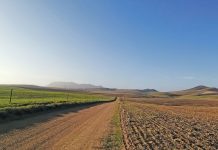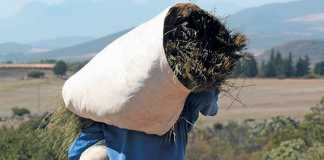When I was young, 4x4s were few and far between, and the odd Jeep or Land Rover made you stop and stare. But good roads were just as scarce back then, especially across our borders. When going into wild country or even the desert, however, you had to do it with what you had: guts, skill and an ordinary car.
But today just about everybody drives around on good roads in thirsty 4x4s of which most hardly ever see the end of the tarmac. It seems to me that in both eras we’ve used the wrong tool for the job. There are many cases where even the state uses the wrong tool, sometimes deliberately or out of ignorance.
Currently, the term biodiversity is a very popular buzzword. The Department of Environmental Affairs and Tourism (DEAT) is getting away with the misuse of this popular and politically acceptable ecological term to serve as a cover under which it can manufacture draconian laws, which have no bearing on biodiversity. It is allowed to do this because so few people understand the true meaning of the word.
Biodiversity literally means the variety of living organisms, both large and small. In theory it sounds good to safeguard or to restore the biodiversity of what is left of our natural ecosystems. To do this, however, one must have a good knowledge of the environment and the myriad of species that inhabit it, as well as sound ecological insight into the principles underlying the concept of diversity. It will also serve field sportspeople well to understand the concept. In any undisturbed natural ecosystem the communities that inhabit it consist of a small number of species that are relatively abundant and a large number of species that are relatively rare. The few abundant species are characterised by either numerous individuals, a large biomass, a high productivity rate or a combination of these factors, and are important as they are largely responsible for the energy flow through that ecosystem.
The importance of the large number of rare species is that they largely determine the biodiversity of the ecosystem. This holds true for both plant and animal species on land and in water, and each has a direct influence on the other. If the abundant species are allowed to become super-abundant it will impact negatively on the rare species and will lead to an unbalanced ecosystem with low biodiversity.
For example, if an abundant species such as impala is allowed to become super-abundant it will overgraze the abundant plant species (grass) and bush encroachment will occur. This will further suppress the grass and have a negative effect on rare grazers like roan and sable antelope, as well as numerous smaller rare species that depend on a habitat with good grass cover to survive. This will eventually lead to a dramatic decline in biodiversity.
For decades this has occurred in the Kruger Park and other reserves as well as many game ranches where bush encroachment has taken on alarming proportions. This is the type of scenario where DEAT could have, through legislation aimed at preserving or restoring biodiversity by proper veld management of these ecosystems, prescribed and assisted in providing remedial measures. Instead the National Environmental Management: Biodiversity Act 2004 deals with matters that have nothing to do with biodiversity.
Although biodiversity is determined by the large group of rare species, the initial list of threatened and endangered species to be protected included a bizarre collection of abundant animals such as common duiker, blesbok, springbok, black-backed jackal, caracal and porcupine. Numerous rare species and entire groups of really endangered species, like amphibians, were almost totally omitted. Changes to the list were effected through public pressure, but who are supposed to be the experts?
Tightening the grip on hunting
What the act does deal with, among others, is hunting. Under the biodiversity cloak it prescribes measures seemingly intended to disrupt the lives of all hunters and turn it into a bureaucratic nightmare. H unting is by no means banned outright, but by placing enough restrictions upon hunters and hurdles in front of them it may succeed where the Firearms Control Act failed – to persuade the majority of hunters to swap their rifles for golf clubs. It’s clear that there are forces within the department that are working towards a dispensation in which it will almost be impossible to hunt, and in so doing bring the game ranching industry to its knees. Consider that listed species can only be legally hunted in an “extensive wildlife system”, but if there is any “human intervention” like the control of parasites or provision of healthcare or water, or supplementary food, except during drought, it is considered as a ”controlled environment” in which hunting is illegal. To legislate this under the innocent banner of biodiversity is the wrong tool for the job, done either out of ignorance or malice, but what it does succeed in is making the possible true intentions just that much harder to detect. unters now find themselves increasingly in the crossfire from different conflicting legislative acts.
The Firearms Control Act forces “dedicated hunters” to belong to a hunting association accredited by the SAPS, while the same does not apply to “occasional hunters”. But when the Norms and Standards regulations under the Biodiversity Act were released by DEAT minister Marthinus van Schalkwyk, he issued a press statement which read, “Hunting will now be permitted only by hunters registered with recognised hunting bodies.” The “recognition” of a hunting body by DEAT does not mean accreditation granted by the SAPS. For this recognition a “hunting body”, which now includes those for professional hunters and outfitters, must also belong to a single national association of hunting. To operate in any of the nine provinces a hunting organisation must, according to the act, “apply to the MEC responsible for biodiversity management in the province for recognition as a hunting organisation in that province”, the granting of which will depend on, among many other things, whether it has a clear policy on BEE.
But alas, it does not end there.
Under this act, new regulations were also drafted about the type of weapons allowed in hunting any listed species, even though the SAPS had already stipulated that every hunting organisation was to issue an endorsement for every hunting weapon indicating its suitability. However, clause 14.2 (a) (vii) of the hunting regulations of the Biodiversity Act states an “animal may not be hunted by means of a firearm other than a rifle or a handgun specifically designed for hunting purposes”. This effectively rules out the .303 as well as rifles in .308, 30-06 and .223, as these calibres were all originally developed for war and many handguns, ideally suited for hunting, were possibly originally designed for silhouette shooting. Bow hunting was also originally totally banned, but after public appeals SAPS changed its mind and only banned hunting “dangerous” game with a bow, although bow hunters have for years demonstrated that at the appropriate range a modern bow and arrow can be just as effective as a rifle. Under the same law it was made illegal to breed or introduce game in areas were they did not “originally” occur, whenever that was. DEAT cracked down on canned lion hunts and aim to introduce restrictions on elephant safaris. These issues have nothing to do with biodiversity and suggest that there is a complete misunderstanding in the department about the meaning of the term.
Animal Rightist Movement’s aim
If anyone is in doubt that these measures of DEAT can eventually culminate in the end of hunting as we know it and the collapse of the entire game ranching industry, they must think again.
Likewise, if you cannot see the hand of the Animal Rightist Movement (ARM) in all this madness you must be blind. We must realise that ARM’s aim is to destroy all systems whereby humans derive any benefit whatsoever from any animal because they claim it will violate its rights. At the top of its banning list are all forms of hunting, culling, slaughtering or fishing, and includes any form of livestock farming or wildlife management. The difference between the reactions expressed by the Confederation of Hunters Associations of SA (Chasa) and the SA Hunters and Game Association upon the release of the above-mentioned new hunting regulations is significant. Rather than forming a united front against the implementation of the views of the combined enemy (the ARM lobby), their reactions represented the two opposite poles of the opinion spectrum. While Chasa applauded the regulations, SA Hunters condemned them and in so doing played right into the hands of the enemy. The reason for these conflicting opinions is that the organisations don’t know the enemy and neither do most of us, which allowed ARM to find a fertile breeding ground in a new “democracy” like ours. These misguided people are unrelenting. If you understand them, you will know they cannot be appeased and will never stop. To compromise and yield an inch today will only ensure that tomorrow’s battle will be a mile closer to your own castle. – Abré J Steyn For more information contact Abré J Steyn on 082 253 4822. |fw












